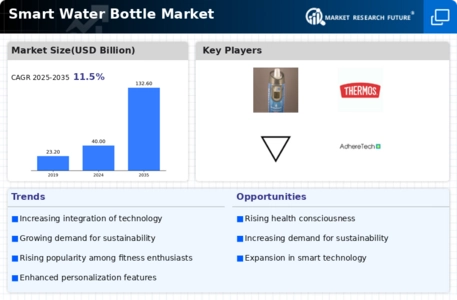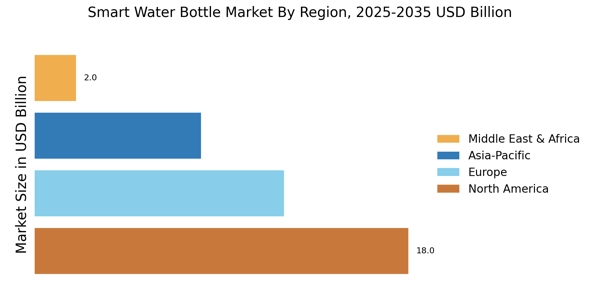Technological Advancements
Technological advancements play a crucial role in shaping the Smart Water Bottle Market. The integration of IoT technology, sensors, and mobile applications into smart water bottles enhances user experience and functionality. These innovations allow users to track their water intake, set personalized hydration goals, and receive notifications, thereby promoting healthier habits. The market for smart devices is expanding rapidly, with projections indicating a compound annual growth rate that could exceed 20% in the coming years. This technological evolution not only attracts tech-savvy consumers but also encourages traditional water bottle users to transition to smarter alternatives, thereby driving the growth of the Smart Water Bottle Market.
Rising Health Consciousness
The increasing awareness of health and wellness among consumers appears to be a primary driver for the Smart Water Bottle Market. As individuals become more health-conscious, they seek innovative solutions to monitor their hydration levels. This trend is reflected in the growing demand for smart water bottles that offer features such as hydration tracking, reminders, and integration with fitness apps. According to recent data, the health and wellness market is projected to reach substantial figures, indicating a strong correlation with the smart water bottle segment. Consumers are increasingly prioritizing products that contribute to their overall well-being, suggesting that the Smart Water Bottle Market is likely to experience significant growth as a result.
Customization and Personalization Trends
Customization and personalization trends are emerging as significant drivers in the Smart Water Bottle Market. Consumers increasingly desire products that reflect their individual preferences and lifestyles. Smart water bottles that offer customizable features, such as color, design, and functionality, are likely to attract a broader audience. Market Research Future indicates that personalized products can lead to higher customer satisfaction and loyalty, which is crucial in a competitive landscape. As brands recognize the importance of catering to diverse consumer needs, the Smart Water Bottle Market may experience growth driven by innovative, personalized offerings that resonate with consumers.
Increased Fitness and Outdoor Activities
The surge in fitness and outdoor activities is another key driver for the Smart Water Bottle Market. As more individuals engage in physical activities, the need for hydration solutions becomes paramount. Smart water bottles that cater to athletes and outdoor enthusiasts by providing features such as temperature control and durability are gaining popularity. Recent statistics indicate a rise in participation in fitness-related activities, which correlates with an increased demand for smart hydration solutions. This trend suggests that the Smart Water Bottle Market is likely to benefit from the growing fitness culture, as consumers seek products that enhance their active lifestyles.
Sustainability and Eco-Friendly Products
The growing emphasis on sustainability and eco-friendly products is significantly influencing the Smart Water Bottle Market. Consumers are increasingly aware of environmental issues and are seeking products that align with their values. Smart water bottles made from sustainable materials and designed for long-term use appeal to environmentally conscious buyers. Market data suggests that eco-friendly products are gaining traction, with a notable percentage of consumers willing to pay a premium for sustainable options. This trend indicates that the Smart Water Bottle Market could see a rise in demand as brands innovate to meet the expectations of eco-aware consumers, potentially leading to a more sustainable future.


















Leave a Comment